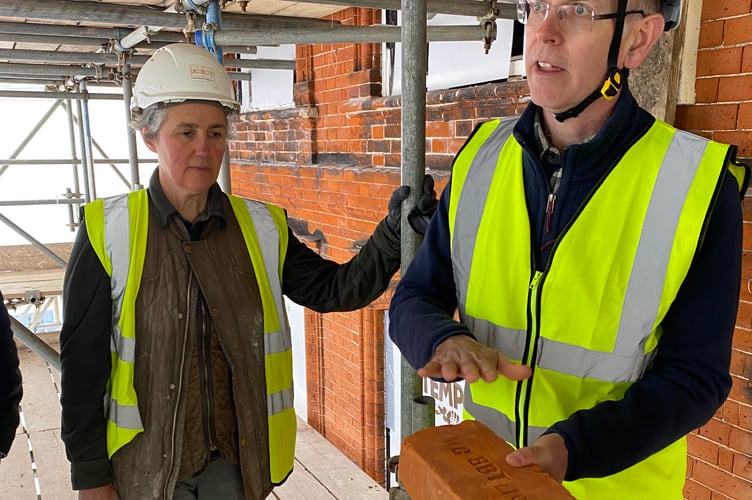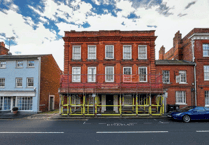One of the most exciting restoration projects in the whole UK is taking place in Farnham.
But don’t take our word for it: Being involved in the restoration of Willmer House is more exciting than working on a Roman villa in the Balkans according to the project’s lead consultant.
“I’ve only done a rebuild like this once before,” said a beaming Graham Abrey from his scaffolding perch high above West Street.
“The precision and care that’s gone into this is building has just been outstanding.
“Farnham is one of the best kept Georgian towns in the UK and this is an exceptional quality building. Being part of this project is a once in a lifetime opportunity.”
Willmer House – known to most as the building housing the Museum of Farnham – is a rare architectural gem, mainly because of its brickwork.
While many people are fans of Georgian architecture, they weren’t the best builders and many houses were built with the “just chuck it in” approach. Millionaires who have snapped up examples in central London have often found this to their cost, with some fine Georgian terraces being literally built on soil.
The creator of Willmer House did things differently. John Thorne was an “extravagantly wealthy man” and wanted to flaunt his wealth in architecture.
The entire frontage of the property was built in gauged brickwork, traditionally only used for arches and decorative purposes, with only a few examples remaining in the UK. The bricks were locally made while every single one was cut and shaped by hand to a “very specific size”.
The result is a masterpiece of design and architecture, so no wonder Graham is happy to be working on it.
He said: “Gauged brickwork is the most expensive form of building construction historically and it’s more expensive than natural stone.
“This building is a really important building because the whole façade has been built this way.
“We only have a very small selection of buildings like this, maybe only 24. Gauged brickwork is usually for arches and decorative purposes, not whole buildings.
“The owner was obviously a very wealthy chap and he wanted to show off that wealth in this extravagant way.
“He built to a very high standard, which itself is unusual for Georgian times. We’ve got this beautiful façade but it’s also been built to an incredibly high standard.”
The Herald got the chance to go behind the scenes last week at the landmark project. After meeting the team and some heavily involved Waverley councillors on the ground floor, we donned our hi-vis jacket and hard hat before ascending the ladders and scaffolding to the roof top.
You don’t really appreciate what a fine building Willmer House is until you a get a perspective like this.

Hidden away from passing cars and pedestrians by a wall of scaffolding and sheeting is a rare and “spectacular” building that has wowed everyone involved in the project.
“We wanted to make sure this very beautiful house was retained for the people of Farnham and for those who built it in the first place,” said Cllr Kika Mirylees, WBC Portfolio Holder for Community Services, Leisure and EDI.
“It was really important this didn’t end up being sold.”
“It was a can that had been kicked down the road many times and we had the chance to try and fix it, or just try and sell it,” added Cllr Merryweather, WBC Portfolio Holder for Finance, Assets and Property.
“It didn’t take very long for us to decide to fix it once and for all. It’s one of the nation's most important historic buildings and conservation projects such as this on a Grade 1 Listed Building are unique.”
Like every grand design of this magnitude and age, some issues will arise. Most architects aren’t fans of Georgian builders but they did a grand job, while those from later centuries less so.
Experts found that a later parapet wall that didn’t match the original brickwork had been “tacked on” with cement, with the material being used in large quantities elsewhere.
Restoration work started in January and is being carried out by team of highly experienced specialists, including brickwork, joinery, and leadwork conservators.
Management & Construction Services Ltd (MSC) are working in close collaboration with the likes of WBC and Farnham Town Council on the project, which is currently focused on the careful recording, dismantling and rebuilding of the upper front elevation.
Work on dismantling the parapet wall, cornice and second floor window heads is also underway, with damaged brickwork being replaced with identical hand-cut and rubbed gauged bricks.
The original timber sash windows dating from 1718 will be restored with other works including cleaning and repairing the leadwork, guttering, and downpipes, and removing modern paint coating from Portland stone casings.

Bricks are selected and shaped by hand, with no power tools involved, to keep things authentic. The team is loathe to reinstall removed bricks, which are catalogued, as they want the façade to have a perfect consistency.
“If you’re investing a lot in repairing the building you don’t want to be putting anything back that’s doubtful,” said Emma Simpson MBE of Simpson Brickwork Conservation.
“The team here have worked on the chimneys at Hampton Court Palace. There’s nine in our team and we’re lucky to be involved in this as the precision and care that’s gone into this outstanding.”
“It is such a high-quality building, built with local materials and the bricks would have been made in this area,” added Mr Abrey.
“There was a painstaking testing to get the colour and consistency right with the bricks we’re using and every brick has been rubbed down to size.”
And speaking of bricks…
With restoration work now well underway, WBC is giving residents the chance to leave their own lasting legacy through a ‘Buy a Brick’ campaign.
Well-wishers are being given the chance to play their part in the preservation of the building and its incredible façade by sponsoring a hand-crafted brick.
Sponsors will also have their name added to a plaque inside the Museum of Farnham, while there’s a further incentive for people who really want to splash out.
The 24 people who become a 'Names in Bricks' sponsor will also receive an illustration of Willmer House showing the precise location of their engraved brick and a digital photograph.
Cllr Mirylees added: “By sponsoring a brick, you become part of our mission to restore and preserve this amazing local building but will also, forever be, a part of the fabric of the Museum.
“It is such an important project and testament to our dedication to maintaining our heritage sites for future generations. We do hope many residents and visitors will get involved."
Different levels of donation from ‘The People’s Brick’ to ‘The Golden Brick’ are available with the latter including an ownership certificate and invitation to the grand reopening. If you are interested in sponsoring a brick visit www.waverley.gov.uk/BuyABrick
The Willmer House restoration project is supported by the National Heritage Fund and a DCMS Museum Estate and Development grant secured through Arts Council England, alongside contributions from WBC, Farnham Town Council and the Farnham and District Museum Society.





